#jacques buron
Text
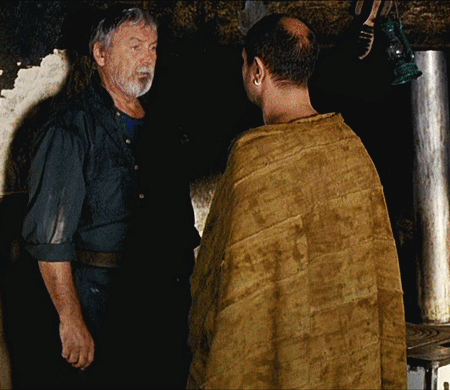

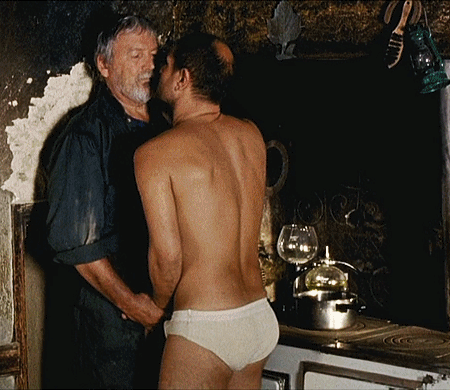


Éric Bougnon & Jacques Buron in Time Has Come (2005)
84 notes
·
View notes
Text

I had no idea this meme painting was made by Jacques-Louis David 😂😂
Also, he made it the year Napoleon was born, 1769
#why is David kind of iconic??#lmfao#Madame François Buron#David#jacques louis david#18th century#1700s#1769#robe à la française#France#French art#rococo#baroque#Louis xv#art#art history#art meme#art memes#portrait#18th century portrait#Art Institute of Chicago#Jacques-Louis David#French#women in art#women#women reading
92 notes
·
View notes
Photo

Madame Francois Buron, Jacques-Louis David, 1769
#madame Francois buron#jacques louis david#Jacques-louis david#david#1769#1760s#1700s#18th century#portrait#painting#reading#art
133 notes
·
View notes
Photo

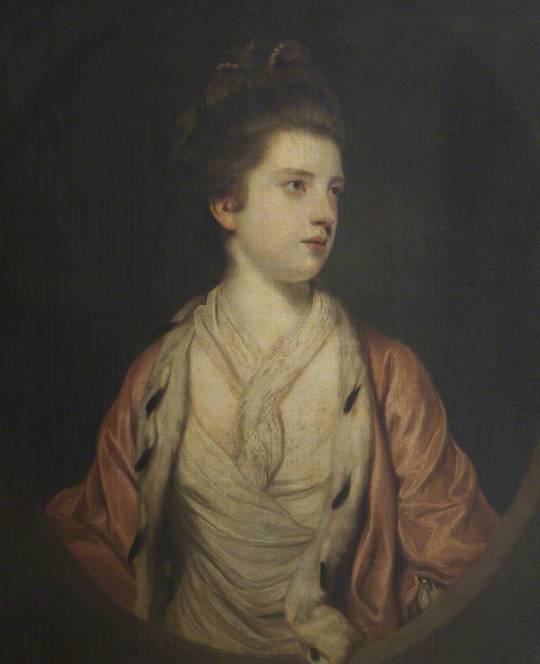





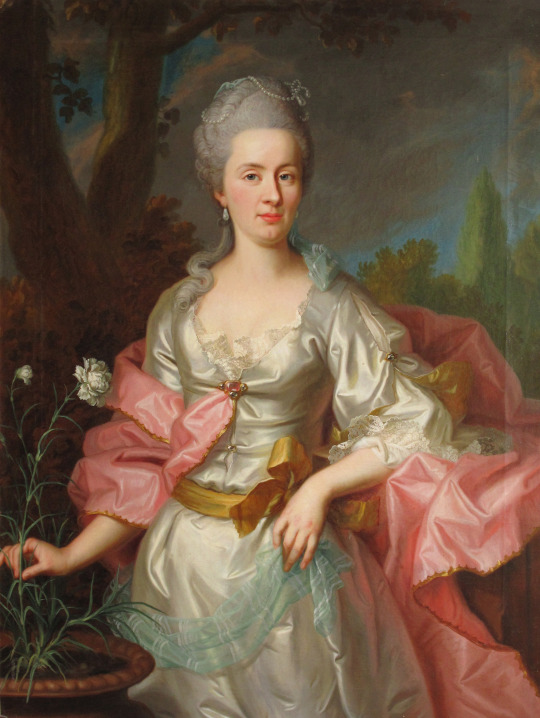

And 1769 -
Top: ca. 1768-1769 Sir Watkin Williams-Wynn and his Mother by Sir Joshua Reynolds (Tate Collection - London, UK). From the Tate Collection; this image was very heavily spotted throughout. Spots on the people were individually removed while the background was blurred to remove them with Photoshop.
Second row left: 1769 Elizabeth Fortescue (1745–1780), Countess of Ancram, Later Marchioness of Lothian by Sir Joshua Reynolds (Blickling Hall - Blickling, Norfolk, UK). From Wikimedia 976X1200 @72 193kj.
Second row right: 1768-1769 Princess Frederika Sophia Wilhelmina (1751-1820) of Orange, nee Prussia by Johann Georg Ziesenis (Mauritshuis Museum - Den Haag, Netherlands). From Wikimedia 1200X1715 @72 336kj.
Third row: 1769 John Jennings Esq., his Brother and Sister-in-Law by Alexander Roslin (Nationalmuseum - Stockholm, Sweden) From gestbergman.blogspot.se/2011/03/alexander-roslin 1600X1305 @180 641kj.
Fourth row left: 1769 Marie Francoise Buron by Jacques-Louis David (National Museum of Fine Arts of Algiers - Algiers, Algeria) From wikiart.org/en/jacques-louis-david/portrait-of-marie-francoise-buron-1769 1594X1920 @144 4.4Mp.
Fourth row right: 1769 Marquis de Marigny et de sa femme, née Marie-Françoise Constance Julie Filleul by Louis-Michel van Loo (Musée du Louvre - Paris, France). From Wikimedia 3216X4263 @180 5Mj.
Fifth row: 1769 Isabella,Viscountess Molyneux, later Countess of Sefton by Thomas Gainsborough (Walker Art Gallery - Liverpool, Merseyside, UK). From Wikimedia; increased exposure 2822X4351 @38 pixels/cm 4.6Mj.
Sixth row left: 1769 Augusta Katharina Lerber geb. Stürler by Jakob Emanuel Handmann (Schloss Jegenstorf - Jegenstorf, Kanton Bern, Switzerland). From Wikimedia 2599X3455 @72 2.6Mj.
Sixth row right: 1769 (or after) Elizabeth Kerr, née Fortescue, Marchioness of Lothian (1745-1780) by Sir Joshua Reynolds (auctioned by Sotheby's). From Wikimedia 3679X4800 @125 7.3Mj.
#1769 fashion#Georgian fashion#Louis XV fashion#Rococo fashion#Joshua Reynolds#Elizabeth Fortescu#Princess Frederika Sophia Wilhelmina of Orange#Johann Georg Ziesenis#family portrait#Alexander Roslin#Marie Francoise Buron#Jacques-Louis David#Marie-Françoise Constance Julie Filleul#Louis-Michel van Loo#Isabella-Viscountess Molyneux#Thomas Gainsborough#Augusta Katharina#Jakob Emanuel Handmann#Elizabeth Kerr#fur trim
17 notes
·
View notes
Text
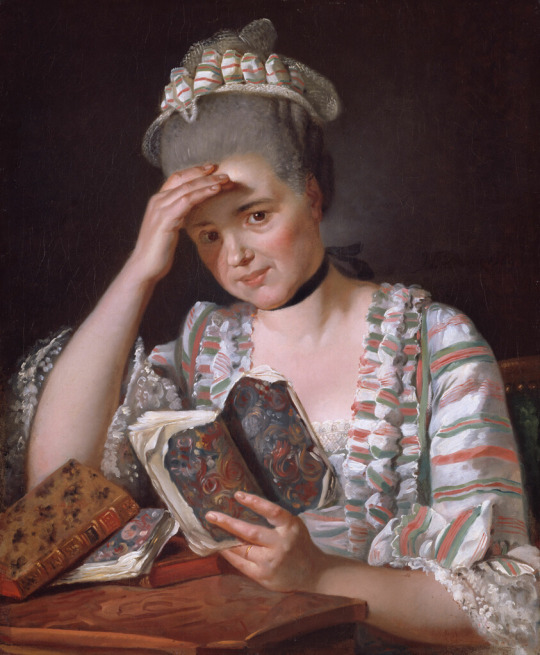
Madame Francois Buron (1769)
By: Jacques-Louis David
10 notes
·
View notes
Text
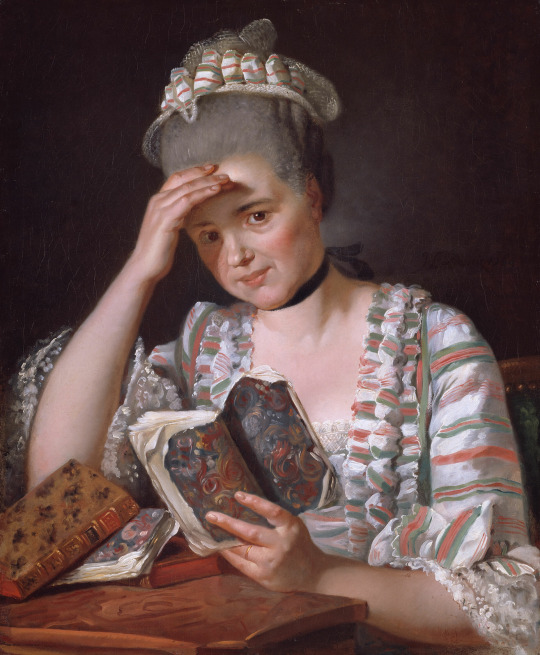
Jacques-Louis David - Madame François Buron
1 note
·
View note
Text
A zonzo per la Francia: David, il pittore della Rivoluzione
Il pittore che visse una fase cruciale della storia francese…
Jacques-Louis David nacque il 30 agosto 1748 a Parigi da Marie-Geneviève Buron, parente alla lontana del celebre artista François Boucher e Louis-Maurice, un commerciante di ferro.
Continue reading A zonzo per la Francia: David, il pittore della Rivoluzione

View On WordPress
0 notes
Text
Highlights from the Art Institute of Chicago
This place is too damn big and too expensive. It will take more than one day to see everything and I'm not spending another $19 USD (student discount) I skipped over the Art of the America's and Egyptian exhibits and I wish I didn't.

Janine Antoni; Mortar and Pestle, 1999
The curator(?) walked past me as I came around the corner saw this and audibly ughed. She got a chuckle out of it.
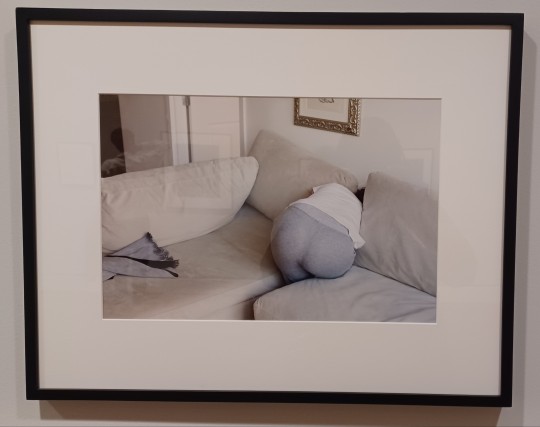

groana melendez; Pierina Cleaning, Harlem, NYC, US, 2016
JMW Turner, Valley of Aosta Snowstorm, Avalanche, and Thunderstorm
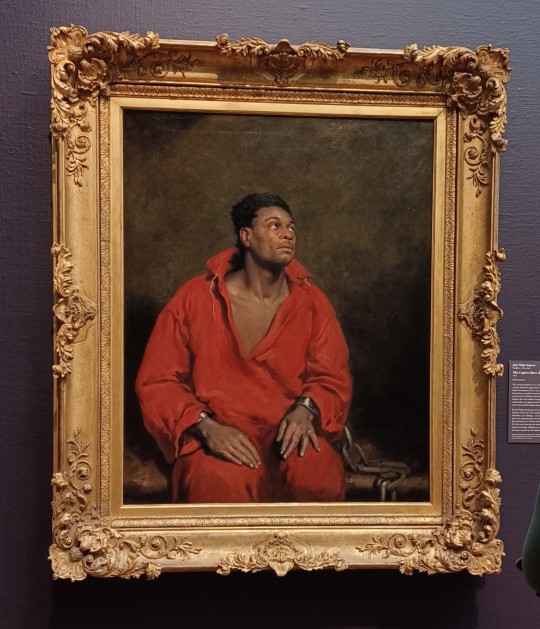

John Philip Simpson; The Captive Slave (Ira Aldridge), 1827
Francis Bacon; Figure with Meat, 1954

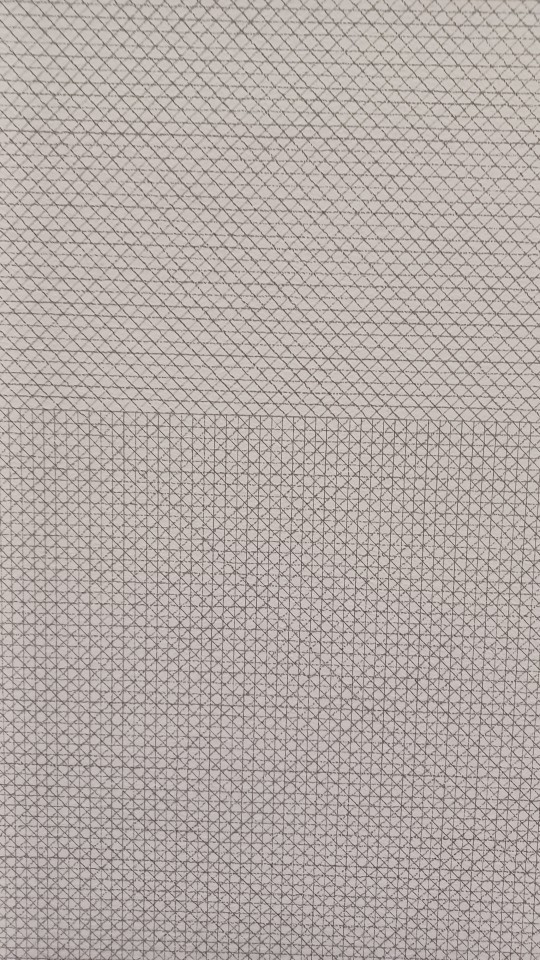
Sol le Witt; Wall Drawing No. 6 [really long title, 1971

Helmut Jahn

Jacques-Louis David, Madame François Buron, 1769

John Baldesarri; The Fallen Easel, 1988
Yamani Nayar; Pursuit, 2011
#art institute of chicago#chicago#contemporary art#jmw turner#sol lewitt#helmut jahn#Francis Bacon#photography#painting#modern art
1 note
·
View note
Photo

"Madame François Buron"
by Jacques-Louis David French, 1748–1825
Oil on canvas
France, 1769 Unordered List: - Jacques Louis David is known for his neoclassical style of painting and his revolutionary paintings that depicted the events of the French Revolution. - Madame François Buron was a wealthy French woman who was admired for her intelligence, wit, and beauty. - The years 1769-1799 marks a turbulent period in the history of France during the French Revolution. - Madame François Buron was painted by David in 1786, nine years before the start of the Revolution. HTML Paragraph: Jacques Louis David's painting of Madame François Buron in 1786 captured her intelligence and beauty. The painting is neoclassical in style, which was fashionable in France at the time. It features Madame François Buron in an elegant posture, dressed in grand garments with her hair tied up. The painting serves as a reminder of the pre-revolutionary period in France between 1769 and 1799, a time of great social and political unrest.
Always at your service,
AI Art Detective
This blog took 307 OpenAI tokens.
This image and it's meta-data are courtesy of The Art Institute of Chicago's public API, which you can visit here.
1 note
·
View note
Text
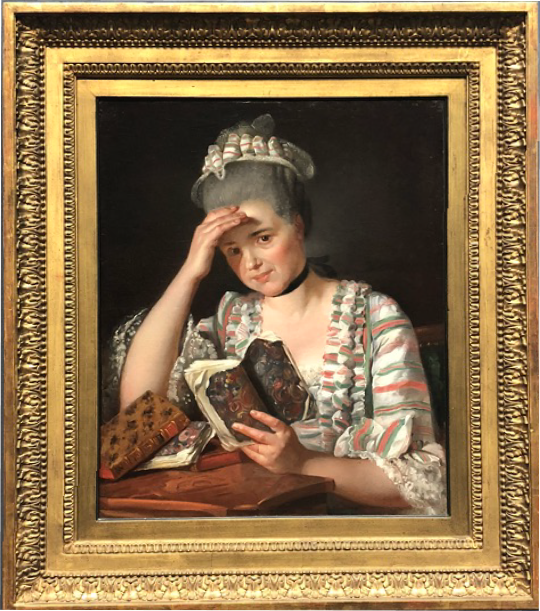
Portrait of Madame François Buron, by Jacques Louis David, as it appears in the Art Institute of Chicago
#I had to make this crop for a class so I decided just to share#bc this is one of my favorite paintings
1 note
·
View note
Photo

Portrait de Marie-Joséphine Buron, 1769, Jacques-Louis David
Medium: oil,canvas
24 notes
·
View notes
Photo
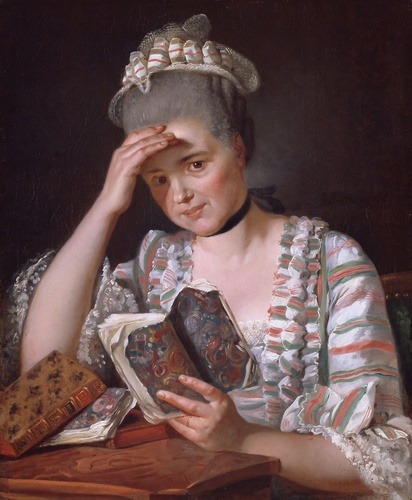
Madame François Buron, Jacques Louis David, 1769, Art Institute of Chicago: European Painting and Sculpture
Restricted gift of Mrs. Albert J. Beveridge in memory of her mother, Abby Louise Spencer (Mrs. Augustus Eddy).
Size: 26 1/8 × 21 7/8 in. (66.3 × 55.5 cm)
Medium: Oil on canvas
https://www.artic.edu/artworks/88632/
117 notes
·
View notes
Photo

featuring Madame Francois Buron by Jacques-Louis David
3 notes
·
View notes
Text
He opens his atelier to students- His marriage- Salon of 1783
David's talent engaged some young artists to ask him for advice. Thus was founded this famous atelier where students came to study what France and Europe counted as distinguished in the arts. His first student was Germain Drouais, whose father and grandfather were esteemed as portrait painters. He had been placed by his father in the atelier of Brenet, but he left him, attracted by David’s renown. Wicar, Fabre, and Girodet also enjoyed the first of his lessons.
As agréé, David was entitled to a dwelling in the Louvre. To discuss the appropriation of this new residence he was addressed to the contractor of the King's Buildings: that is, to M. Pécoul, the father of the friend David had left behind in Rome. On receiving him (note: at his house), M. Pécoul reminded David of the message he had been entrusted with. The artist apologised for his forgetfulness, and having explained the object of his visit, he begged Monsieur Pécoul to come and have lunch with him at the Louvre and there to examine the changes to be made in his apartment. Having accepted, this excellent man found the cover put on the canvas of Funeirailles de Patrocle. He first scolded the artist for his carelessness with his works; then, while questioning David as to his future intentions with regard to deciding the layout of his interior, M. Pécoul made known to him the desire of his son to see that David should marry one of his sisters. A desire, he confessed, that he shared completely on his own side. He ended (their meeting) with an invitation to visit his family, in order to meet with the eldest of his daughters, whom he intended for him.
David asked for time to reflect, and going to Sedaine's, he told him the facts and begged him to give his opinion. The latter, putting aside any personal ambition- because he had treasured for his daughter the idea of a marriage with his young friend- strongly approved of this alliance. He brought out all of its advantages and insisted on the justly deserved esteem that David’s future father-in-law enjoyed among members of the Acadamie d'Architecture.
M. Pécoul was indeed in a good situation of fortune, and the proposition he had just made to a man still only rich in glory and esteem showed to what high sentiments his heart was inclined. He also loved the arts, and, seeking for the society of the artists he had, to get closer to it, leased the empty rooms of his dwelling in the rue du Coq to Ducret, architect, and to Moreau, designer.
David, following Sedaine’s advice, answered the invitation he had received, and thus made acquaintance with Mademoiselle Charlotte Pécoul. This girl was endowed with the most gracious gifts of nature; without having perfectly regular features, the radiance of her complexion and her eyes lent to her countenance a charming animation, perfectly in keeping with the vivacity of her mind. On entering this family, David found in his brother-in-law a friend who had bound himself to him by the conformity of their tastes; finally, the fortune of his wife, in assuring him independence, enabled him to follow in the arts the road that he had traced for himself.
The marriage, soon decided, was celebrated on May 16, 1782, as the following act states:
Thursday, 16 of May 1782. M. Jacques-Louis David, painter to the King and his Académie, aged thirty-three and a half years, son of Louis-Maurice David (deceased), a former merchant, and Mme Marie-Geneviève Buron, quai de la Mégisserie, on the one hand; and Mlle Marguerite-Charlotte Pécoul, aged seventeen years, daughter of M. Charles Pierre Pécoul, contractor of the King's Buildings, and lady Marie-Louise Lallouette (deceased), de jure and de facto, rue du Coq, on the other; both of this parish, were affianced and married of their mutual consent and with the permission of the curé, myself undersigned, priest, bachelor in theology, practioner and master of ceremonies in this church, following the publication of a ban made in this parish without opposition, and by the exemption of the two others granted by Monseigneur the Archibishop of Paris, allowing permission to betroth and marry the same day. Signed: d'Argent, Vicar-General; date insinuated and checked on the tenth of this month and year.
The witnesses for David were: Francis Desmaisons, architect to the King, and François Buron, landscaper, his uncles; those of Miss Pécoul, Nicolas Ducret, architect to the King, and Joesph Lalouette, lawyer in the Parlement (of Paris) and King’s Council, her cousins.
The bride's beautiful mother-in-law, her brother and two siblings signed the act of marriage along with the other parents and witnesses.
This change in position did not slow David's eagerness for work.
He finished his painting, Andromaque, for the Salon (note: of 1783) a piece that the Academy had designated for his reception, and which they approved the sketch of in their session of March 29, 1783.
He brought to this work the same search for an antique character. He showed an accurate and learned design in Hector's head and feet, and he utilised the props from his documents sketched in Italy, borrowing more from the Romans than from the Greeks. As to the color, by exaggerating the dark tonality suitable to a scene of this kind, he fell into the defects of his preceding paintings.
At the same time, he was working on a painting completely outside of his aspirations: for David’s studies, which had all been pagan, in no way prepared him for religious painting, and his Saint-Roch, where the interest is chiefly called to human suffering, belonged, rather, to history. But here one could not escape the difficulty, for the Marshal de Noailles had asked him for a Christ on the cross. He painted this figure by perhaps too rigorously copying his model, taken from amongst the marshal's soldiers. Once placed in the Capucine church, this painting attracted such curiosity that this inconvenient crowd was, we believe, the real reason that the donor decided to remove it from the public eye.
These two canvases, along with two portraits and a drawing, formed David’s contribution to the Salon of 1783.
The works are designated in the catalogue:
By M. David, Agréé
No. 162: The pain and regrets of Andromache on the body of Hector, her husband, 8.7 x 6.4 pieds
No. 163: Two portraits of the same number
No. 164: Drawing of a frieze in the antique genre
No. 165: Other paintings of the same number
The Andromaque obtained honourable success: (though) it was regretted that the colour too dark. Critics also sought to find within it a memory of the Testament of Eudamidas by Poussin; they joked about the importance of the helmet posed at the foot of the bed; but in general, Andromache’s expression and the qualities of the drawing that offered the body of Hector were appreciated.
The Christ who, without being designated on the catalog, must be understood as included in number 165, was found to be too violet in tone too violet; as we learn from the ‘Salon at the auction’.
Of the two portraits, that of his uncle Desmaisons was severely judged: one did not recognize the brush of the painter of Belisaire in it. As for the second, some biographers instead designated it as that of David’s doctor, Albert Leroy. The portrait of the latter, which now adorns the musée de Montpellier, offers, in our opinion, details which would certainly have given it the attention of the critics, so let us believe that his portrait was present at this exhibition.
The drawing of a frieze in the antique genre, representing a warrior triumphing over his enemy before Minerva, Hercules and the Fates, had been executed in Rome in 1780.
On the 23rd of August, before the opening of the Salon, Vien had presented the Andromaque to the Académie, who, on the basis of this piece of painting, had conferred upon David the title of academician.
5 notes
·
View notes
Photo





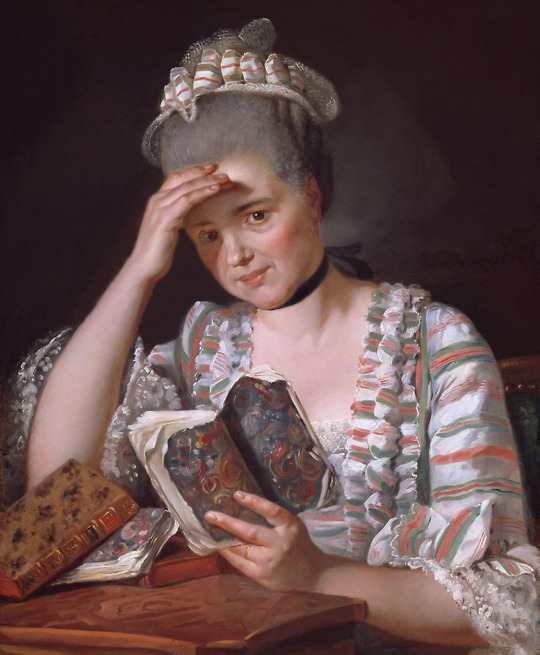
Back to the 1760s, the height of engageantes (from top to bottom) -
ca. 1762 Lady in a Pink Silk Dress by Allan Ramsay (Yale Center for British Art, Yale University - New Haven, Connecticut, USA). From artuk.org 998X1200.
ca. 1762 Woman in Blue (previously known as 'Miss Edgar') by Thomas Gainsborough (Ipswich Borough Council Collection, specific location ? - Ipswich, Suffolk, UK). From artuk.org 1542X1928.
1765-1770 Sophie Charlotte von Haus née von Bennigsen by Johann Georg Ziesenis (Saarland Museum - Saarbrücken, Saarland, Germany). From tumblr.com/lenkaastrelenkaa 732X958.
Lady by Giuseppe Baldrighi (location ?). From tumblr.com/lenkaastrelenkaa; fixed spots w Pshop 1195X1388.
Rosalie Levasseur by Louis Michel van Loo (location ?). From the lost gallery's photostream on flickr; blurred background & fixed spots elsewhere w Pshop 1564X1928.
1769 Madame Francois Buron by Jacques-Louis David (location ?). From tumblr.com/catherinedefrance; fixed cracks & some spots w Pshop 843X1022.
#1760s fashion#Louis XV fashion#Georgian fashion#Rococo fashion#Allan Ramsay#lace cap#lace choker#fichu#Thomas Gainsborough#sacque back#straight hair#lace engageantes#Johann Georg Ziesenis#lace stomacher#lace mantle#Giuseppe Baldrighi#Louis Michel van Loo#high coiffure#hair jewelry#Jacques-Louis David
20 notes
·
View notes
Photo
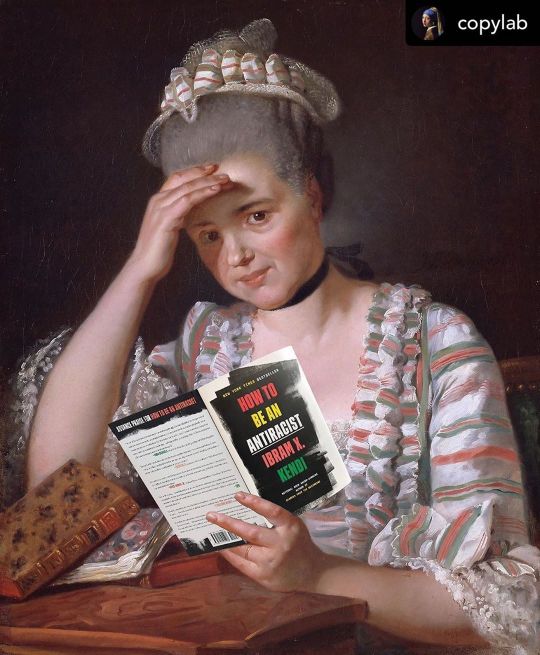
Posted @withregram • @copylab You too can be the white woman educating herself. Original: Jacques-Louis David’s “Madame Francois Buron” Added: Ibram X. Kendi’s “How to Be an Antiracist” #readit #unlearn #howtobeanantiracist #ibramxkendi #educateyourself📚 https://www.instagram.com/p/CB2DqXGAsE0/?igshid=mi5x1c5mfz2n
0 notes